USL Super League Style Guide, 2024-2025
How do the eight teams in the USL Super League set themselves apart tactically?
Halfway in to the USL Super League’s inaugural season, tactical identities have blossomed across the league. All eight clubs have played more than a dozen matches, which is an ample sample size to start drawing conclusions about each team’s philosophy.
Which players have stood out as being especially important? What stories do the numbers tell? I’m here to dig in, analyzing a team’s attacking and defensive tendencies, assessing a mocked-up depth chart1, and offering up key statistics for the entire Super League.
The data is broken down into indicators of overall performance, attacking stats, and defensive stats. Some numbers - expected goals, possession, points per game - are self-explanatory. Others aren’t as clear, including:
Passing Distance: A measure of the forward distance (in yards) that a team’s average passes travels.
Long Build Percentage: The share of a team’s goal kicks and own-third restarts that are taken long.
PPDA:2 An estimated value of passes allowed in the attacking half weighted against defensive actions; a lower value signifies a more aggressive, effective pressing system.
GSAx: The number of goals allowed minus a goalkeeper’s expected goal conceded; negative values signify stronger goalkeeping.
With that out of the way, let’s dig in.
Brooklyn FC
1st Place
Brooklyn is, by a comfortable distance, the best team in the USL Super League thanks to their suffocating, press-led approach. Plenty of teams post solid defensive records by sitting in, but Brooklyn and manager Jessica Silva weaponize their 4-1-4-1 shape as a two-way bludgeon.
Consider that the New Yorkers sit first in the Super League in xG against and second in xG for, all without maintaining a majority of possession. This team is ruthlessly efficient, but their defensive structure - anchored around center backs Allison Pantuso and Kelsey Hill as well as stay-at-home midfielder Sam Kroeger - makes it cohere.
In the press, Brooklyn is extremely good about compressing space and ranks second in the USL in PPDA. Some of that quality owes to the height of the back line, which limits press-breaking passing lanes downfield. Side-to-side shifting further upfield does the rest.
You get an example of that defensive system here. The clip highlights one particular moment where forward Luana Grabias, right back Sasha Pickard, and a slew of midfielders within the 4-1-4-1 have trapped DC against the sideline. It’s a perfect of example of Brooklyn’s pressing philosophy.
Now consider the play from start to finish. At each stage, Brooklyn is maintaining the sideline trap and closing at angles that restrict the opposition. Both Grabias and right winger Mackenzie George - who would get my vote for league MVP at the moment - are extraordinarily heady in the way they close down to deny a central cutback.
As soon as Jessica Silva’s side regains, they’re off to the races. Grabias’ read is particularly strong; she knows exactly when to peel off, get central, and take her chance.
That tempo upon re-gaining is classic Brooklyn. Whether they create havoc by overwhelming the wide areas or flexing their No. 8s up as pressers, this club never wastes a moment on the ball. Side-to-side ball movement against an unsettled defense is a regularity. So, so many of Brooklyn’s shots come from George-to-Garziano-to-Cox moves from right to left or vice versa; their attack is a hydra.
Throw in complete goalkeeping from Sydney Martinez and Neeku Purcell, both of whom are expected to play a bit of sweeper-keeper, and you’ve got a wonderfully coherent system from front to back. Brooklyn is the most aggressive and, thus far, best team in the Super League.
Carolina Ascent
3rd Place
Carolina began the 2024 season on an 11-game unbeaten run that spotlighted a well-structured 4-4-2 and the excellence of Meagan McClelland in goal. Neither especially pressureful or remarkably slick with the ball, the Ascent excelled because of their team defense and considerate combination play.
Sydney Studer and Vicky Bruce were at the heart of that success. The duo combined to feature alongside one another for more than 1,200 minutes in central defense, representing 97% of the Ascent’s gameplay so far. Carolina doesn’t hold an especially high line, seeking to frustrate opponents into long balls and low-percentage crosses rather than lunge for takeaways. With 151 total blocks and clearances between them, Studer and Bruce have made that style work.
Philip Poole’s side is fairly patient in build, mixing in the occasional long ball with a more modest approach anchored around Taylor Porter in the pivot of their 4-4-2. Less a progressor than a circulator, Porter is good at receiving under duress, distributing bounce passes, and buying time for runs to develop in the process.
Two strands of offense tend to reign for the Ascent: one common route is to engage forward Mia Corbin on the drop. The other, as seen above, centers around bold switches of play.
The example sequence begins with left back Renee Guion, Carolina’s most ambitious passer, on the ball near halfway. Ahead of her, the midfield line is tucked-in, especially with the right winger camping low in the half space.
That alignment forces the defense to compress, and it allows Guion to hit a switch. Her pass finds the Ascent strike pair - Corbin and Kathrynn Gonzalez in this case - both making runs toward the left. The unified movement forces the opposition ever narrower, and right back Ashlynn Serepca can thus find acres of space on the far side. A shot on target ensues.
Other wide players like Jill Aguilera (who’s played a bit of full back and winger) and the more attacking-minded Jaydah Bedoya (second on the team in goals) have been equally efficacious for Carolina. When this team is clicking, the give-and-take between Porter and Corbin’s gravity down the middle and all the verve on the sidelines is definitional.
That compact and structured attacking mien benefits the Ascent defensively, allowing them to slip into low block with relative ease. Even when the defense has failed, McLelland - first in the league in goals prevented - has come up big time and again. Carolina isn’t the flashiest, but their principled style is getting results.
Dallas Trinity
2nd Place
After settling into a 3-5-2 shape a few weeks into the fall, Pauline MacDonald’s Dallas Trinity quickly ascended the table. Trinity tend to build out short from the back in that s, but they aren’t afraid of driven, vertical passes to break lines once they’ve bent a defense out of shape. No team in the Super League presses more effectively, a line-breaking passes that end in turnovers are quickly recovered.
You’ll note above that Sam Meza, the midfielder that made Dallas’ system sing throughout the fall, is marked with a strikethrough on her name. That’s because her loan spell from the Seattle Reign is up as of December. With 3.2 successful dribbles and an 83% pass completion rate, Meza has been both efficient and dynamic down the middle; she’s the club’s linchpin between the lines, and her potential loss is a big deal.
That said, Dallas isn’t a one-woman show. Indeed, nine Trinity players have scored in 2024. Eight of those players have two goals or less; the productive burden has been dispersed. Scoring can come from Allie Thornton - the team leader with six goals - doing the job as a true No. 9, a wing back making a cut inside, or a late-arriving center mid. Variety is this club’s strength.
Defensively the principles that underpin the MacDonald system are solid, with pressing triggers well-drilled across the board. You’d expect Dallas’ 3-5-2 to keep ticking regardless of who’s in the lineup come spring.
Across these two frames, you see the Trinity press arrive in waves. To start, Dallas’ press is aligned in 3-1-4-2 mode, with defensive midfielder Amber Brooks - who leads all center mids in long pass completions (3.2) and clearances (2.1) per match - as the “one” holding things down between the lines. Meanwhile, the two more advanced No. 8s shadow the members of the Fort Lauderdale pivot.
When the opposition drops their No. 10 low to try and overload Dallas, Brooks steps up and tracks that player. Her advance forces a backpass, and that’s when the Trinity strike. Both forwards tighten the screws, and left wing back Chioma Ubogagu closes to the receiver. Suddenly, Dallas is in a tilted 3-4-3, with that upward-hinging action from Ubogagu proving to be exactly what’s needed for Dallas to unsettle their guests.
The defensive excellence extends across phases. This team has allowed just 2.3 xG on set pieces thus far, mixing solid coverage in the box with an overall discipline and a tendency to avoid sloppy fouls.
Going both ways, Dallas’ depth has been a strength. Players like Cyera Hintzen, a quick forward, and Jenny Danielsson, a more physical between-the-lines attacker, have come up big late in games. Rachel Pace is a viable starter at left wing back that offers up a vastly different skillset to Ubogagu. Jordyn Hardeman is a semi-regular starter in defense as a teenager and looks like a vet with the ball at her feet.
No matter who’s playing, Dallas feels well-organized and sharp. Since landing on their 3-5-2 system, this team has more than established themselves as a contender in the Super League, one of few that has a viable shot at a tile.
DC Power
6th Place
For the lion’s share of the fall campaign, DC defended in a 4-4-2 but attacked with a back-three shape. To get there, they’d flex right back Susanna Friedrichs up the sideline and allow the right winger to essentially become an additional forward. It was a progressive gambit, but it led to suboptimal results and left the Power mostly without a clear tactical identity. Thus, manager Frederic Brillant was dismissed before the winter break.
So, yeah, DC Power is a bit of a mystery heading into the spring. In their lone game under interim manager Phil Nana, the Power avoided the shape-shifting. Of course, DC then lost that game 3-0 to a typically poor Lexington team, so…uh…back to the drawing board?
The gulf between DC’s solid underlying numbers and disappointing results is marked. With just seven goals scored - six less than second-to-last Spokane - the Power have been wildly unlucky. Nowhere is that clearer than through star striker Jorian Baucom, who was benched at the end of the first half after underperforming her xG by 2.9 goals, the second-largest gulf in the division.
Finishing has been the primary issue in the nation’s capital, and DC’s defensive structure has mostly been okay. Yes, they’re joint-seventh in terms of goals allowed, but Brillant’s off-ball 4-4-2 often highlighted his squad’s best traits.
That 4-4-2 is seen in mid-block above, but the way in which the Power push back their foes is impressively flexible. The play begins with forward Mariah Lee dropping low, marking a member of the opposing pivot and denying a defense-shifting bounce pass. When the Lexington midfielder receives, she immediately has to reset without affecting DC’s shape.
Tight marking stands out from there. Katie Duong, working from DC’s midfield line, tracks a runner upfield; Lee stays low and marks a Lexington full back making a half space run. Because Duong and Lee trade places so neatly, the guests are forced back again, whence they’re finally goaded into a risky pass.
Defender Madison Wolfbauer - who rates in the 87th percentile for defensive actions and, more granularly, the 93rd for takeaways as compared to other center backs - dispenses with Lexington’s move from there and helps to quickly move play upfield. That’s the platonic ideal of a DC play. Either Wolfbaeur or fellow center back Claire Constant bullies the opposition off the ball, and a vertical break ensues.
The best iteration of this team will have a few obvious traits in that vein. Duong (96th percentile xA) and Wolfbaeur must be allowed to be expressive. The wingers should be encouraged to leak out on the counter. Baucom must be involved in all phases. Whether Nana’s all-situations 3-4-3 can do the job is the question.
Fort Lauderdale United
4th Place
Fort Lauderdale has been a team of runs thus far. Their six victories have come across two discrete three-game winning streaks, both of which were predicated on Tyrone Mears tweaking his system. By switching into a back four starting in December, Mears unlocked a new gear for United; their box-shaped midfield may be the most exciting in the USL.
Much of that success starts with Addie McCain. Variously used as a striker or No. 10, McCain leads the league with eight goals, but she also ranks in the 95th percentile of attackers in terms of passes per match. As long as the former Texas A&M star is getting touches, Fort Lauderdale - most often seen in a 4-2-3-13 down the stretch - can cook.
That’s the case here, with McCain and forward Kiara Pralle both dropping in as potential receivers. The attackers are on the same axis as Taylor Smith and Felicia Knox in the pivot. Meanwhile, the wingers tear over the top as the opposition has to focus on all that central action.
To that end, the first-choice wide duo of Sh’nia Gordon and Jasmine Hamid has been stellar. Gordon leads the team with 26 shots on top of 15 successful dribbles; Hamid ranks third with 15 shots and second - only behind McCain - with three goals. Both players have done well in the new 4-2-3-1 to engage overlapping full backs like Sabrina McNeill and double down on the danger.
United previously preferred a 3-5-2 without the ball that shifted into a three-box-three in possession. In that setup, McCain pressed like a forward before dropping power to help overload the central areas. Still, using Gordon and Hamid as ostensible wing backs in defensive block was a recipe for danger given the massive amount of space they needed to cover.
That said, Fort Lauderdale has conceded just three shots on the fast break all season long, amounting to 0.6 xGA. That’s far and away the best number in the league. Without the ball, Fort Lauderdale isn’t especially pressureful, preferring to let the danger come to them. There’s a reason why center backs Laveni Vaka and Celia Gaynor have rated out in the 26th and 4th percentiles for takeaways, respectively.
Adventurous steps into the midfield aren’t their prerogative in the first place. Mears sets this team up to force mistakes, not make them with rash play at the back. That’s why United looked like a contender to end the fall slate.
Lexington SC
8th Place
Never accuse Lexington of playing boring soccer games. Their matches have seen a total of 50 goals scored; that’s almost 50% higher than any other club.
The high-event style is a byproduct of defensive aggression that shows great promise but hasn’t come together often enough. Lexington has exclusively used a back four thus far, and the club encourages their defenders to step up to receivers with aplomb. Their front-to-back cohesion has lacked (see last-place pressing metrics) and errors have been a commonality, but manager Michael Dickey and his team haven’t lacked for intensity.
That said, the 4-2-3-1ish look that Lexington sports is still defined by clear, strong ideas. When this team is clicking, they’re unapologetically fun.
Lexington likes to close hard in their half, denying opponents with tight marking and a mobile back line. Often, the full backs are expected to push from a flat defensive line to deny space and cut out line-breaking passes. Many teams delegate that responsibility to deeper-seated defensive mids; Lexington tries to be more positive, allowing full backs like Julia Mackin or jack-of-all-trades Nayeong Shin to do the deed.
At best, that philosophy discourages opponents from progressing and allows Dickey’s front lines to force turnovers. That verve has allowed Lexington to rank second in the league in fast break xG; they’re first with three actual quick-strike goals.
When this team is cooking, Madi Parsons - variously used as a striker or No. 10 - is leading that charge and racking up takeaways. Parsons is a bulldozer in transition, capable of going it on her own (see a team-high 21 shots) or involving scoring-minded wingers like MaryKate McGuire and Cori Sullivan.
Madison Perez has been Lexington’s unexpected offensive driver, but not in a traditional sense. The center back has created 15 chances and picked up a whopping five assists from set pieces in 2024. For Perez to be that prolific from the center back spot (and for fellow defender Sydney Shepherds to lead the league with four set piece goals!) won’t last, but Lexington’s profligacy on dead balls is a sign of latent offensive spark.
It’s been a platoon in Dickey’s net for the most part, with Bridgette Skiba (504 minutes, -0.4 GSAx) and Sarah Cox (900 minutes, +3.7 GSAx) sharing time. Skiba’s goals prevented mark greatly outpaces Cox’s, but both goalkeepers are united by a tendency to boot it long.
In theory, that direct style would feed the high press in a virtuous cycle of territorial dominance. In practice, the execution hasn’t been there for Lexington - the defining trait of this team to date.
Spokane Zephyr
7th Place
No team has underperformed their expected goals more than Spokane. The Zephyr are patient and intentional on the ball, shifting from a baseline 4-1-4-1 into a possessive 2-3-2-3 that maximizes space for star winger Emina Ekic and retains creative options between the lines. That hasn’t led to enough success in front of goal.
This season, McKenzie Weinert and Emma Jaskaniec are two of the three biggest xG underperformers in the league. I’ve been very, very positive about Weinert’s movement on the right side, and Jaskaniec has stood out because of her unselfish hold-up play and follow-up runs, but both players have been snakebit where it counts.
It’s why a Zephyr team that leads the USL in total xG has only scored 13 times. Spokane has seven goals from dead ball situations - more than half of their total return - and has produced 50% more set piece xG than anyone else, but they’ve faltered when the ball is live.
In the run of play, Spokane is at their best when they can control the match, leveraging that attacking shape to bend defenses out of sync. The beauty of Jo Johnson’s system is its versatility; this team is superb about interchanging at every level when they’re at their sharpest.
Here, it’s Haley Thomas and Ekic trading places between the left back and left wing spots. Thomas is an interesting case in her own right, having started the year as more of a reserve center back before nailing down a full back role when the opportunity arose.
In this case, the Bosnian international’s drop draws the opposing right back, thereby giving Thomas the space to overlap. Meanwhile, Marley Canales and Sophie Braun - the No. 8 or No. 10 types in the 2-3-2-3 - push toward the edge of the box to possibly receive and shoot. That the Zephyr don’t actually generate a chance here is probably telling, but the principles are extremely sound nonetheless.
Defensively, Spokane mostly prefers to sit in a 4-2-3-1, though that can vary. The club’s better pressing moments feature Taylor Aylmer - who I didn’t praise enough as a metronomic passer from the No. 6 spot and who leads the team with 22 interceptions - remaining low as her pivot partner pushes high.
The effect is to create a 4-1-4-1 with two of Braun, Canales, or Katie Murray clogging the central areas and maybe even pistoning ahead to harangue a ball-carrier. At their defensive best, Spokane employs that second-wave pressure out of the midfield to plug holes and force turnovers.
At the back, it took time to find the right balance, but moving Thomas to the left and starting Julianne Vallerand (77th percentile duel wins, 100th percentile aerial wins) has more than solidified the flanks. Though Zephyr conceded five times in their final two matches, they were on a two-goals-allowed-in-five run beforehand. Find that defensive level anew, finish good chances, and this’ll be a solid playoff contender.
Tampa Bay Sun
5th Place
Arguably the most sophisticated possession team in the Super League, Tampa Bay took their lumps in the opening weeks but found their level later in the fall. Manager Denise Schilte-Brown’s 4-2-3-1 has been relatively fluid all year, but overloads in the half spaces have been a constant. An improving ability to keep three or four players behind the ball, adding much-need structure in defense, has allowed the Sun to truly shine.
Amidst the upswing, the face of the team has changed as international signings have settled in. Stalwarts like Jordyn Listro and Sydny Nasello continue to anchor the squad, but later-arriving players like defensive midfielder Jade Moore and striker Natasha Flint came up big down the stretch.
Indeed, both Moore and Flint - both originally from England - have given the Sun a new facet. Moore’s staid presence has given Listro more freedom to roam, turning the 4-2-3-1 into more of a 4-1-4-1 in possession. The Sun are the USL’s most dominant possession team, but the re-jiggered midfield balance let them use the ball more effectively
Flint, meanwhile, is as classic a No. 9 as they come. Her size and finishing - see four goals in the final five matches of the fall - free up space for other players. As a result, Flint sets the table for Tampa Bay and maximizes space for those aforementioned half-space overloads.
Consider the example build move mapped out here. As a rule, Tampa Bay is constantly trying to find numerical advantages where they’re most dangerous. That usually happens by creating a trio with, say Listro and an advancing full back pushing forward.
Carlee Giammona, the Sun’s primary No. 10, is key to the calculus. Her movement is a constant asset in that pursuit of overloads. A five-goal scorer thus far, Giammona stands out for her ability to move from side to side and bounce passes between opposing lines.
Indeed, here’s a real freedom of movement when Tampa Bay gets going. The attacking midfield is highly fluid, and the shape itself can morph into more of a 2-1-4-3 at especially brave moments.
That motion can lead to trouble after turnovers, given that the Sun’s counterpress has been high-risk, high-reward in 2024. When it works, it’s been a tool to catch opponents out and activate the Sydny Nasellos of the world on the dribble. Too often, though, Tampa Bay has struggled to contain breakout sequences and left their center backs unshielded against odd-man rushes.
The goalkeeper spot is one to watch come February. Ashley Orkus started 2024 in sizzling form before cooling off and being displaced by Lauren Kozal. With Kozal’s loan up, the onus will be on Orkus to come good. More generally, the burden is on this entire defense to communicate more effectively and find their balance.
Still, we’ve seen the upside already. When Tampa Bay clicks from front to back, there might not be a better team in the league.
The depth charts aren’t going to be perfect. I’ve found that there’s been a lot of squad rotation so far this season, and clubs like DC were still switching up their starting lineups well into the fall.
There’s no public source for this when it comes to the Super League, so I’m jury-rigging an estimate by combining passes conceded in the attacking half, tackles, and interceptions and then scaling it against values from comparable competitions.
4-2-2-2? Four-box-two? I don’t know what to call the shape! It’s hard to convey width across lines with the classic model of formation nomenclature.


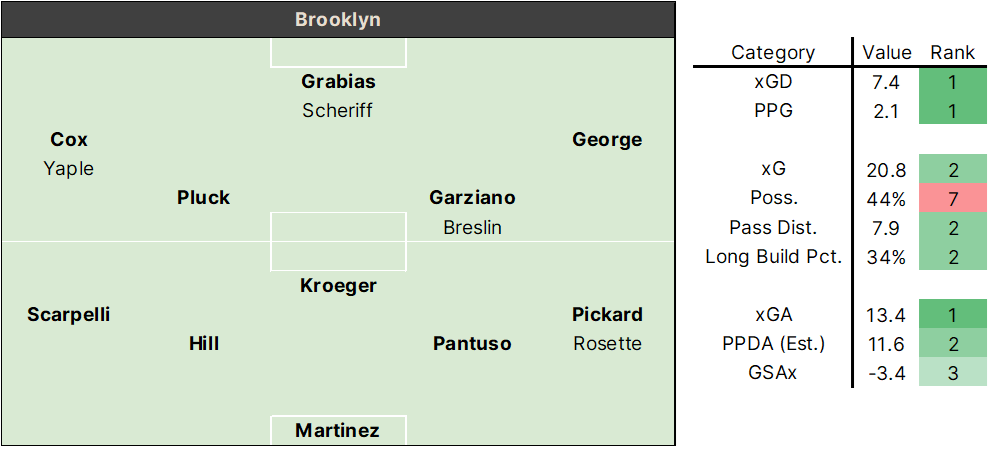
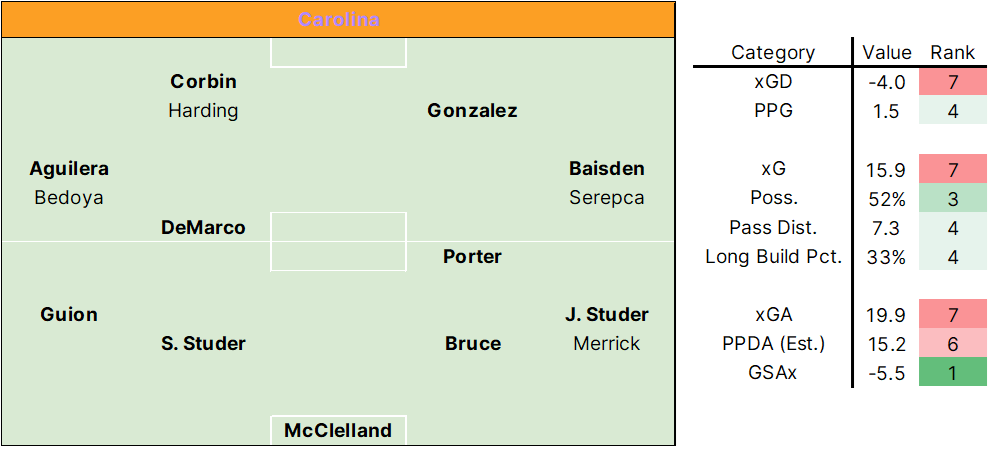
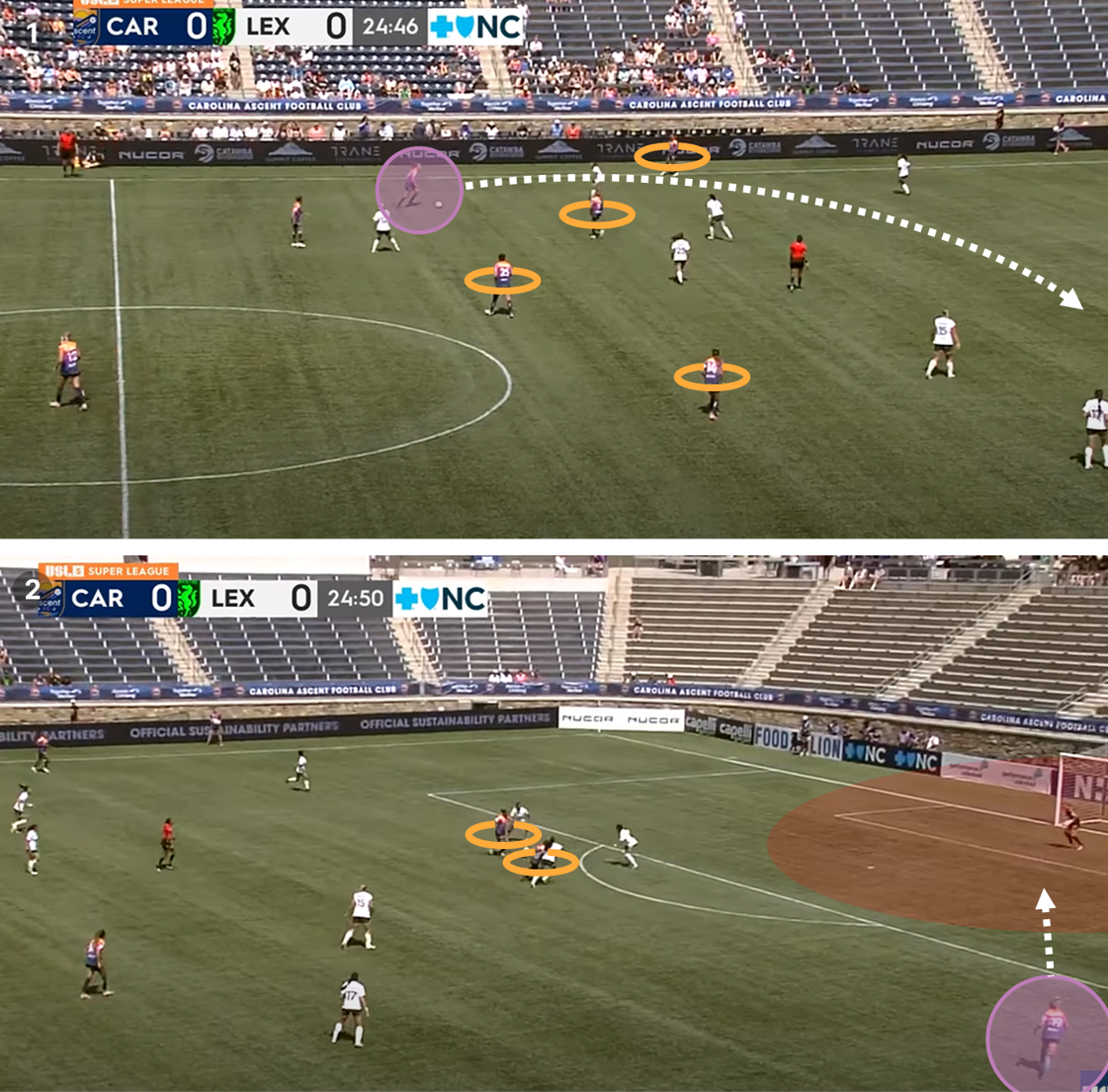


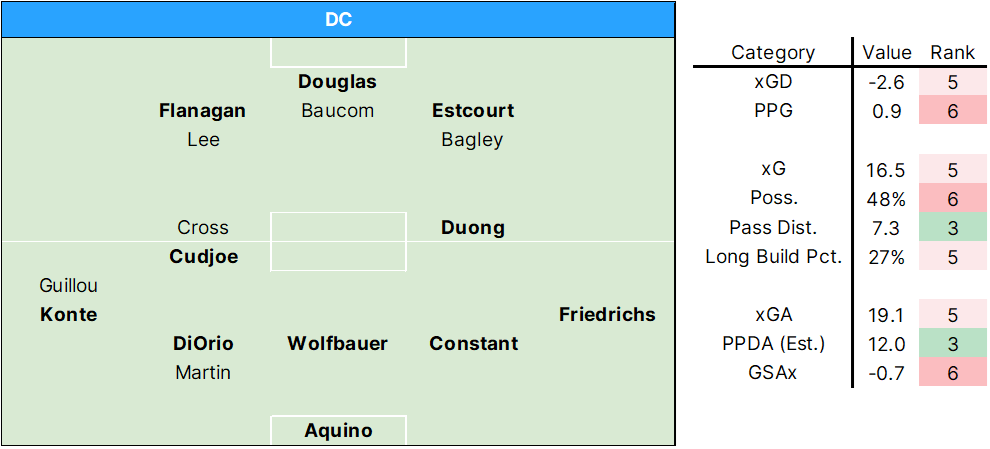



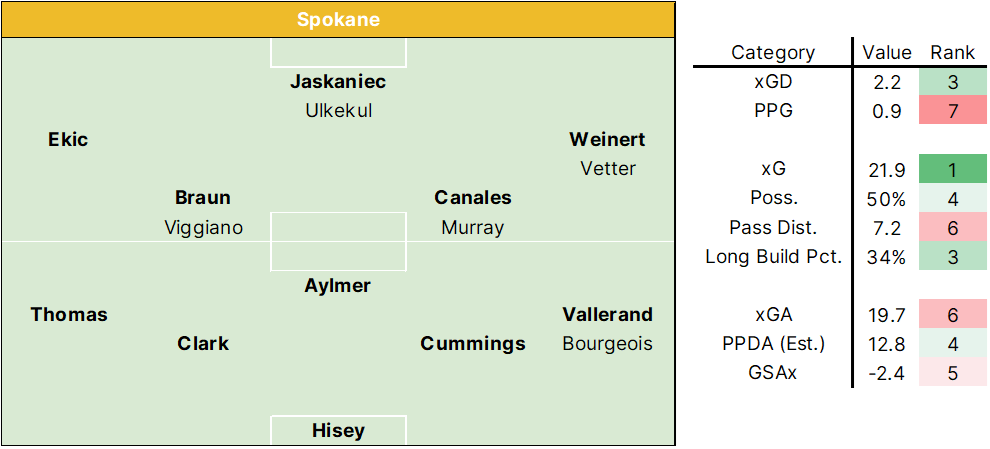


Great piece, John. Could you elaborate on the process you used to determine PPDA for each team, especially regarding the scaling of values from comparable competitions you mentioned in the footnotes, and how you went about that?
Lovely piece John, by last time I check the Velocity play in USL1 😂